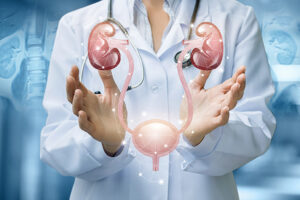 Urinary tract infections (UTIs) affect approximately 35% of women at least once in their lifetime, compared to 10-12% of men. This disparity is attributed to the short female urethra (about 5 cm, a third of the male urethra) and its proximity to the vulva, vagina, and anus, allowing bacteria (especially Escherichia coli) to ascend into the bladder.
Urinary tract infections (UTIs) affect approximately 35% of women at least once in their lifetime, compared to 10-12% of men. This disparity is attributed to the short female urethra (about 5 cm, a third of the male urethra) and its proximity to the vulva, vagina, and anus, allowing bacteria (especially Escherichia coli) to ascend into the bladder.
Frequent UTIs are categorized as honeymoon cystitis, often triggered by sexual activity.
Types of Cystitis
1. Bacterial Cystitis:
- Acute bacterial cystitis (e.g., honeymoon cystitis)
- Recurrent and chronic bacterial cystitis.
2. Non-Bacterial Cystitis:
- Caused by parasites, fungi, or chemical agents.
- Radiation-induced or vascular-related damage.
3. Cystitis of Uncertain Etiology:
- Interstitial cystitis or overactive bladder.
- Pudendal neuropathy-related syndromes
Insights on cystitis
ACUTE BACTERIAL CYSTITIS (UTI)
Acute bacterial cystitis, usually uncomplicated, is primarily caused by E. coli.
• Therapy: Effective antibiotic treatment (e.g., ciprofloxacin, levofloxacin) lasting at least 10 days. However, inappropriate or incomplete antibiotic use can lead to resistance and recurrence.
• Management in Pregnancy: Preferably third-generation cephalosporins; quinolones are avoided in the first trimester.
THERAPY OF ACUTE BACTERIAL CYSTITIS
It is certainly the most common form of cystitis and also the easiest to treat. Simply administer the appropriate antibiotic for no less than 10 days. to resolve the disease. However, it is essential to use the appropriate antibiotic!
What does it mean?
It means not falling into the easy shortcut of self-administering a random antibiotic (perhaps one found at home and left over from other therapies) or one that has done good for a friend in similar situations.
A typical self-administration drug is based on fosfomycin in sachets. This antibiotic, very valid as a bactericide for some bacterial strains, for others it only acts as a bacteriostatic, i.e. it temporarily inhibits bacterial duplication and with it alleviates cystitic symptoms, only to then cause dangerous relapses. However, it has been shown that single-administration therapies are usually poorly effective in this pathology.
So what is the correct behavior?
The antibiotic to be administered is the one prescribed by your doctor and established following a urine culture test with antibiogram. However, I will be told that acute cystitis typically breaks out on weekends or during the night.
The advice then is this.
At the time of the cystitic attack, equip yourself with a sterile container (in the pharmacy or by boiling a glass container for 10 minutes) in which to collect the urine, to take it to the laboratory for culture tests as soon as possible (to be kept in the fridge until delivery !). Immediately after having set aside this urine, one can begin with a self-administered rescue therapy, only to then, once the bacteriological results have been obtained, continue with the appropriate antibiotic, which is usually a quinolone (Ciprofloxacin, Levofloxacin, Norfloxacin or the more modern Prulifloxacin).
The treatment of cystitis during pregnancy, taking into account all the previous recommendations, usually benefits from the use of third generation cephalosporins, while quinolones or tetracyclines are absolutely to be avoided in the first trimester.
Furthermore, to avoid recurrences, prophylaxis with small doses of cefalexin (125-250 mg) or nitrofurantoin (50 mg) is useful.
RECURRENT/CHRONIC BACTERIAL CYSTITIS (RUTI)
Risk Factors
Recurring UTIs affect 20-30% of women who experience acute infections. Risk factors include frequent sexual activity, use of spermicides, and inadequate immune protection (e.g., low local IgA).
Treatment Protocol
The treatment is aimed at:
1. Sterilizing urine and preventing reinfections.
2. Protecting the bladder mucosa.
3. Restoring urothelial glycosaminoglycan (GAG) layers.
Recommended therapies include:
- Initial 10-day phase to achieve bacterial sterility:
- o Full-dose quinolones.
- Rifaximin for intestinal flora regulation.
- Vaginal acidifying agents and probiotics.
- Long-term 6-month phase:
- Low-dose antibiotics every three days or before intercourse.
- Monthly urinalysis to monitor bacterial recurrence.
ADDITIONAL THERAPIES
1. D-Mannose: A natural sugar that binds E. coli, preventing adhesion to the bladder walls and promoting excretion.
2. Hyaluronic Acid + Chondroitin Sulfate: Instilled intravesically to repair the urothelial barrier and reduce inflammation.
3. Amitriptyline: At low doses, this tricyclic antidepressant acts as a sodium channel blocker, alleviating neurogenic inflammation and chronic pain.

